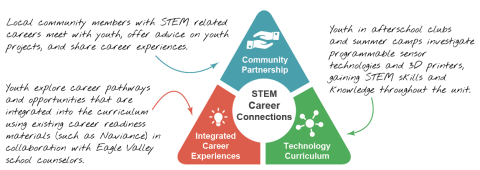Body
Image

STEM Career Connections
Our goal for the STEM Career Connections project is to develop an innovative career readiness model for both in and out of school settings that will profoundly increase the knowledge of, and interest in, STEM (science, technology, engineering, mathematics) and computing careers for middle school youth within Eagle County, Colorado, who are often underserved in STEM fields. To achieve this goal, we have three integral components of the project: • a community partnership working together to support youth engagement in STEM and computing career pathways • a STEM curriculum where youth use advanced technologies (such as 3D printers or programmable sensors) to engage in science and engineering investigations • integrated career experiences that encourage youth to make personally-relevant connections with local STEM and computing occupations. During this three-year research project, we will investigate the following questions: 1. What tools and practices enable a community partnership to support youth exploration of locally relevant STEM and computing pathways? 2. What learning experiences enable middle school youth to create personally relevant connections with STEM and computing careers? 3. To what extent does STEM Career Connections stimulate youth interest and learning in STEM and computing careers?
Pillar 1: Innovative Use of Technologies in Learning and Teaching
students use programmable sensors to engage in locally-relevant, data-enabled science and engineering investigations. Sensor technologies, and their resulting data streams, are a critical component of the big data and machine learning revolution transforming many industry sectors (Makridakis, 2017). Understanding how computers use sensors to perceive the world is one of the five big ideas in the AI4K12 standards (Touretzky et al., 2019) and is central to AI education [ITEST Pillar 1].
Pillar 2: Partnerships for Career and Workforce Preparation.
A key goal of the DTI work was to establish and nurture a community partnership consisting of a dozen individuals representing school district leaders and educators, informal education leaders, local business leaders, parents/caregivers, and students to provide critical coordination, adaptation, and recruiting functions. Importantly, through the partnership, local organizations identified and created complementary learning experiences that used sensor technologies, emphasizing the unique goals of their organizations.
Pillar 3: Strategies for Equity in STEM Education
The STEMCC model and curriculum integrates connections to STEM careers and includes STEM mentoring experiences for students. The STEM career activities involve researching STEM careers that utilize sensors and build on students' interests. Mentors provide first-hand exposure to local STEM careers and guidance to students during project design. Mentors participate in PL, where they learn to create meaningful interactions that are relational and collaborative, building on students’ interests, and culturally responsive.

Discipline(s)
Computer and informational technology science
Data Science
Target Gradespan(s)
Middle school (6-8)
Target Participant(s)
Youth / students
Educators
Hispanic/Latino participants
Project Setting(s)
Formal Education
Informal Education
Category
Developing and Testing Innovations (DTI)